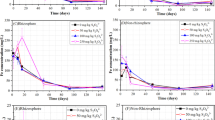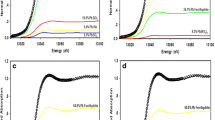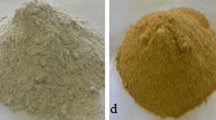Abstract
Kaolin was used as a soil amendment to study the effect of different types of kaolin, pH and arsenic complex on arsenic accumulation in rice grains from arsenic (As) contaminated soil. It was found that kaolin released soluble aluminium (Al) and silicon at a pH value of 3. As adsorption by crude kaolin was higher than by washed kaolin and treated kaolin due to the higher Al content found in crude kaolin. Furthermore, the addition of 5 % (w/w) crude kaolin in the solution of As-contaminated soil was able to reduce water-soluble As in the solution. In mesocosm experiments, As accumulation in rice grain was not found under the addition of kaolin conditions. Scanning electron microscopy with energy dispersive X-ray spectroscopy study found the crystallinity of Al–As complex in plant roots. This implies that while kaolin adsorbs As from As-contaminated soil, rice plants also simultaneously take up As and Al into their cells. This caused the decrease in As accumulation in rice grain.

Similar content being viewed by others
References
Ahmed MF (2001) An overview of arsenic removal technologies in Bangladesh and India, presented at the BUET−UNU international workshop: “technologies for arsenic removal from drinking water”, Dhaka, Bangladesh, p 251
Aksorn E, Visoottiviseth P (2004) Selection of suitable emergent plants for removal of arsenic from arsenic contaminated water. Sci Asia 30:105–113
Belver C, Munoz MAB, Vicente MA (2002) Chemical activation of a kaolinite under acid and alkaline conditions. Chem Mater 14:2033–2043
Brennan F, Moynihan E, Bryan SG, Hillier S, Owen J, Pendlowsk H, Avery LM (2014) Clay mineral type effect on bacterial enteropathogen survival in soil. Sci Total Environ 468–469:302–305
Carter MR, Gregorich EG (2006) Soil sampling and methods of analysis, Canadian society of soil science, 2nd edn. Taylor & Francis, USA
Casado M, Anawar HM, Garcia-Sanchez A, Regina IS (2007) Arsenic bioavailability in polluted mining soils and uptake by tolerant plants (El Cabaco mine, Spain). Bull Environ Contam Toxicol 79:29–35
Chaney RL (1989) Toxic accumulation in soils and crops: protecting soil fertility and agricultural food-chains. In: Yosef BB, Barrow NJ, Goldschmid J (eds) Inorganic contaminants in the vadose zone. Springer, Berlin, pp 140–158
Cornu S, Saada A, Breeze D, Gauthier S, Baranger P (1999) Influence de composés organiques surl’adsorption de l’arsenic par les kaolinites. C R Acad Sci 328:649–654
Garai TK, Das DK, Sarkar S (2000) Effect of iron and zinc application on the availability of native and applied arsenic simulating low land rice condition. In: International conference on managing natural resources for sustainable agricultural production in the 21st Century, New Delhi, India
Garcia-Sanchez A, Alvarez − Ayuso E, Rodriguez-Martins F (2002) Sorption of As (V) by some oxyhydroxidesand clay minerals: application to its immobilization in two polluted mining soils. Clay Mine 37:187–194
Kannica Y, Lek M, Pisuth V, Hari E (1997) Clay mineralogy of Thai soils. Appl Clay Sci 11:357–371
Khan MA, Stroud JL, Zhu YG, McGrath SP, Zhao FJ (2010) Arsenic bioavailability to rice is elevated in Bangladeshi paddy soils. Environ Sci Technol 44:8515–8521
Kinraide TB (1997) Reconsidering the rhizotoxicity of hydroxyl, sulphate, and fluoride complexes of aluminum. J Exp Bot 48:1115–1124
Koonsom T, Inthorn D, Sreesai S, Thiravetyan P (2014) Effect of kaolin on arsenic accumulation in rice plants (Oryza sativa L) grown in arsenic contaminated soils. Environ Eng Res 19(3):241–245
Krishna GB, Susmita SG (2008) Adsorption of a few heavy metals on natural and modified kaolinite and montmorillonite: a review. Adv Colloid Interface Sci 140:114–131
Ladeira ACQ, Ciminelli VST (2004) Adsorption and desorption of arsenic on an oxisol and its constituents. Water Res 38:2087–2094
Li Z, Bowman RS (2001) Retention of inorganic oxyanions by organo-kaolinite. Water Res 35:3771–3776
May M, Nordstrom DK (1991) Assessing the solubilities and reaction kinetics of aluminous minerals in soil. In: Urlich B, Sumner ME (eds) Soil Acidity. Springer, Berlin, pp 125–148
Meltem BB, Aysegul P (2010) A statistical experiment design approach for arsenic removal by coagulation process using aluminium sulfate. Desalination 254:42–48
Mining and Materials Engineering (2012) Prince of Songkla University. http://www.mne.eng.psu.ac.th/staff/lek_files/ceramic/u21-2.htm. Accessed 2 May 2012
Mohan D, Pittman CU Jr (2007) Arsenic removal from water/wastewater using adsorbents – a critical review. J Hazard Mater 142:1–53
Panaullah GM, Alam T, Hossain MB, Loeppert RH, Lauren JG, Meisner CA, Ahmed ZU, Duxbury JM (2009) Arsenic toxicity to rice (Oryza sativa L.) in Bangladesh. Plant Soil 317:31–39
Panda AK, Mishra BG, Mishra DK, Singh RK (2010) Effect of sulphuric acid treatment on the physico-chemical characteristics of kaolin clay. Colloids Surf A Physicochem Eng Asp 363:98–104
Rahman MA, Hasegawa H, Rahman MM, Rahman MA, Miah MA (2007) Accumulation of arsenic in tissues of rice plant (Oryza sativa L.) and its distribution in fractions of rice grain. Chemosphere 6:942–948
Shevade S, Ford RG (2004) Use of synthetic zeolites for arsenate removal from pollutant water. Water Res 38:3197–3204
Vu KB, Kaminski MD, Nunez L (2003) Review of arsenic removal technologies for contaminated groundwaters. U.S. Department of Energy Office of Scientific and Technical Information. http://www.Ipd.Anl.Gov/Anlpubs/2003/05/46522.Pdf. Accessed 1 Jan 2013
Weeranukul P, Choosit P, Pradmal S, Khamput P (2001) The application of kaolin with coconut meal, plywood from corncobs and durian peel in concrete masonry until wall for increasing effective heat protection and lightweight. Rajamangala University of Technology Phra Nakhon. Res Rep 58:1–83
Wieland E, Stumm W (1992) Dissolution kinetics of kaolinite in acidic aqueous solutions at 25°C. Geochim Cosmochim Acta 56:3339–3355
Acknowledgments
This research was financially supported by a grant from the Program for Strategic Scholarships for Frontier Research Network for the Joint Ph.D. Program, Thai Doctoral Degree of the Commission on Higher Education (CHE).
Author information
Authors and Affiliations
Corresponding author
Rights and permissions
About this article
Cite this article
Arnamwong, S., Suksabye, P. & Thiravetyan, P. Using Kaolin in Reduction of Arsenic in Rice Grains: Effect of Different Types of Kaolin, pH and Arsenic Complex. Bull Environ Contam Toxicol 96, 556–561 (2016). https://doi.org/10.1007/s00128-016-1740-8
Received:
Accepted:
Published:
Issue Date:
DOI: https://doi.org/10.1007/s00128-016-1740-8




